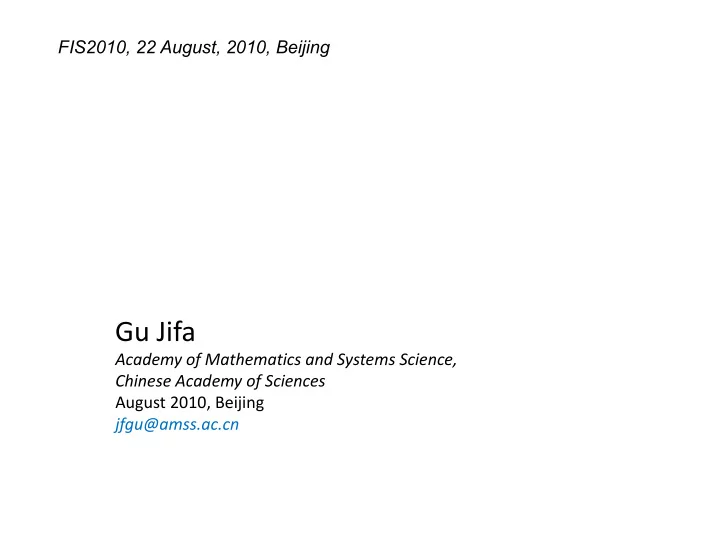

FIS2010, 22 August, 2010, Beijing D-I-K-W-M & C-A-D-P-O-M Gu Jifa Academy of Mathematics and Systems Science, Chinese Academy of Sciences August 2010, Beijing jfgu@amss.ac.cn
Content + I. D-I-K + II. D-I-K-W + III. From D-I-K-W to D-I-K-W-M + IV. Episteme-Techne-Phronesis + V. CADPOM + VI. Knowledge Inheritance
I. D-I-K + Data-Information-Knowledge + The data–information–knowledge hierarchy h as its roots in traditional IT methods and begin s typically by identifying requirements + From these requirements, users and IT experts distil data from these requirements + Data are facts and observations, which in a par ticular context become information + Information used to take decisions forms kno wledge upon which people base actions to ach ieve results
D-I-K hierarcy
Another perspective on D-I-K hierarcy
I.Data-Information-knowledge (first knowl edge-second knowledge -third knowledge-f ourth knowledge) K first knowledge (rough, including N O rearranged Data, Information) W second knowledge (Interesting) L E third knowledge (Actionable) D fourth knowledge (Service for people) G e
From data, Information to first or second knowledge + Data Base + Data house + MIS + Data mining + Text mining + Web mining + DDDM(Domain Driven DM);Intelligent DM
first knowledge-second knowledge -third knowledge-fourth knowledge Knowledge II ( Interesting Knowledge)----- Expert mining Knowledge III ( Actionable Knowledge) Master mining+ Education Knowledge IV ( Available and useful Knowledge) Phronesis
II. D-I-K-W + Data-Information-Knowledge –Wisdom + The " DIKW Hierarchy", also known the "Knowl edge Pyramid", refers to relationships betwee n d ata, i nformation, k nowledge, and w isdom. “ + Typically information is defined in terms of dat a, knowledge in terms of information, and wis dom in terms of knowledge”.
II. D-I-K-W
II. D-I-K-W + In 1987, professor Milan Zeleny mapped the e lements of the hierarchy to knowledge forms: + know-nothing(D) , + know-what(I) , + Know-how (K), + know-why(W)
III. From D-I-K-W to D-I-K-W-M M W W K K I I I D D
III.D-I-K-W-M + Data ( Fact, observation) + Information + Knowledge ( Explicit, Tacit) + Wisdom + Moral (Value—Worldview)
IV. Aristotle: Episteme-Techne-Phr onesis + Episteme (Scientific Knowledge): --Wuli Universal, context-free and objective knowledge (explicit kno wledge) + Techne (Skills and Crafts Knowledge): --Shili Practical and context-specific technical know-how (tacit kno wledge) ) + Phronesis (Prudence/Practical Wisdom): -Renli Experiential knowledge to make context-specific decisions ba sed on one ’ s own value/ethics (high quality tacit knowledge)
IV. Aristotle: Episteme-Techne-Phr onesis + Phronesis is a concept that synthesizes “ knowing why ” as in sci entific theory, with “ knowing how ” as in practical skill, and “ kn owing what ” as a goal to be realized. Unlike episteme, it emph asizes practices in particular contexts. However, phronesis is n ot just knowledge within a certain, particular context per se. S ince it is knowledge to serve the “ common good ” , it implies an affinity with universal principles. + Knowing-creating + Operating-realizing-practicing + Moralizing + Wise 智 , Operable 用 , Morality 德
IV. Aristotle: Episteme-Techne-Phronesis Prof. Nonaka presents six abilities that constitute Phron esis; + Ability to make a judgment on goodness. + Ability to share contexts with others to create *ba*(s hared sense). + Ability to grasp the essence of particular situations/t hings. + Ability to reconstruct the particulars into universals u sing language/concepts/narratives. + Ability to use any necessary means well to realize con cepts for common goodness. + Ability to foster phronesis in others to build resilient organization.
V. CADPOM
V.Six forces for realizing the phron esis by Gu 1.Creativity 创造力 智 慧 wisdom 2. Abstraction 抽象力 3. Dissemination 鼓动力 4. Practicality 实现力 实 践 practice 5. Organization 组织力 6. Orientation 方向力 善美 goodness
V.Understanding of Phronesis by Gu 1. grasp the essence - Creation 2. abstract to theory - Abstraction 3. run exchange, inter-discipline, facilitation- Diss emination 4. realize technique- Practice 5. organize group- organization 6. guide by worldview- moral
V. C-A-D-P-O-M + Creation + Abstraction + Dissemination (Facilitation ) + Practice (Realization) + Organization + Moral (Orientation, Value)
V. C-A-D-P-O-M
V.Process of running phronesis by Gu 6 bad good 1. grasp the essence(C) 2 2. abstract to theory (A ) 3 3 3. run exchange, 4 inter-discipline, facilitation(D) 1 1 4.realize technique(P) 5.organize group( O) 5 6.guide by worldview(M) practice
VI. Knowledge Inheritance Recently we just wish apply a project "On Master-Dis ciple education method in TCM education" supported b y NSFC The intentions of this project are: 1.Develop the traditional master-disciple education met hod, 2.utilize the computer and the expert mining to dig the experiences from famous elder TCM doctors , 3.use the combination of human and computer, 4.Inherit experiences by the combination of master and disciple, 5. Develop the Phronesis ( practical wisdom)
VI.Knowledge Inheritance Knowledge inheritance human Computer Media knowledge handed Learn from Explicit Knowledge Machine Learning down by master each other Self-learning Explicit Knowledge Library Tacit knowledge Knowledge base Brain Fig 2 Knowledge inheritance
VI. Contemporary mode for inheriting the e xperiences and thoughts Academic thought(Wuli) Clinical experience(Shili) Content Master style(Renli) Contemporary mode for inheriting literature survey the experiences and thoughts Education in Univ knowledge handed Teacher-student Method down by master human- computer IT human-network socilization human-human social practice
VI. Knowledge Inheritance + Two system approaches are suggested: 1.Meta-synthesis System Approach 2.Wuli-Shili-Renli System Approach + The first approach is used for knowledge creat ion and synthesis + The second one is used for running phronesis
Thank you for your attention!
Recommend
More recommend